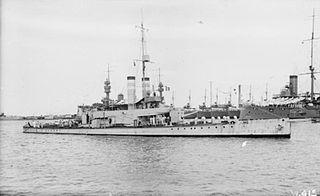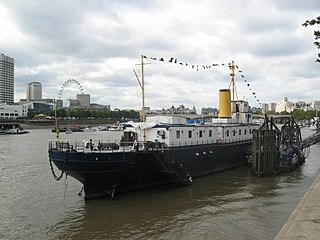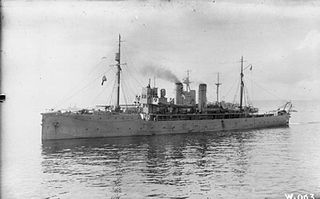
A river gunboat is a type of gunboat adapted for river operations. River gunboats required shallow draft for river navigation. They would be armed with relatively small caliber cannons, or a mix of cannons and machine guns. If they carried more than one cannon, one might be a howitzer, for shore bombardment. They were usually not armoured. The fictional USS San Pablo described in Richard McKenna's The Sand Pebbles is an example of this class of vessel, serving on the US Navy's Yangtze Patrol. Stronger river warships with larger guns were river monitors.

The second USS Panay (PR–5) of the United States Navy was a Panay-class river gunboat that served on the Yangtze Patrol in China until being sunk by Japanese aircraft on 12 December 1937 on the Yangtze River.

HMS Bee was an Insect-class gunboat of the Royal Navy, launched on 8 December 1915. This class are also known as "Large China Gunboats".

HMS Ladybird was an Insect-class gunboat of the Royal Navy, launched in 1916. This class are also referred to as "large China gunboats". Originally built to patrol the River Danube during the First World War, she sailed for China from Malta in February 1927 to serve on the Yangtze River.

The Nanking Incident occurred in March 1927 during the capture of Nanjing by the National Revolutionary Army (NRA) in their Northern Expedition. Foreign warships bombarded the city to defend foreign residents against rioting and looting. Several ships were involved in the engagement, including vessels of the Royal Navy and the United States Navy. Marines and sailors were also landed for rescue operations including some 140 Dutch forces. Both Nationalist and Communist soldiers within the NRA participated in the rioting and looting of foreign-owned property in Nanjing.

The twenty-eight Anchusa-class sloops were built under the Emergency War Programme for the Royal Navy in World War I as the final part of the larger "Flower class", which were also referred to as the "Cabbage class", or "Herbaceous Borders".

HMS Aphis was a Royal Navy Insect-class gunboat. She was built by Ailsa Shipbuilding Company, launched on 15 September 1915 and completed in November 1915. She was based in Port Said at the beginning of World War I, served in Romania and then the China Station until 1940. All of her fighting service was in the Mediterranean, taking part in the invasion of Pantelleria and landings in the south of France, returning briefly to the Pacific in 1945. She was scrapped at Singapore in 1947. Her class was intended for shallow, fast flowing rivers and they also proved suitable for inshore operations when her relatively heavy weaponry could be used to support Army operations.

HMS Gnat was a Royal Navy Insect-class gunboat. She was built by Lobnitz and launched in 1915. Gnat saw service during the First World War as part of a flotilla operating on the Tigris and Euphrates rivers. After the war, the vessel was transferred to China, where in 1927, Gnat took part in the Nanking Incident. Gnat began the Second World War still in China, but was towed to the Mediterranean Sea in 1940. There, the gunboat took part in an assault on Tobruk before being torpedoed by a German submarine. Though Gnat did not sink, and was beached at Alexandria, Egypt where the vessel was used as an anti-aircraft platform. The vessel was declared a constructive total loss and scrapped in 1945.

HMSCricket was a Royal Navy Insect-class gunboat. She was built by Barclay Curle and launched on 17 December 1915.
Seawind Barclay Curle is a British shipbuilding company.

The Arabis class was the third, and largest, of the five sub-classes of minesweeping sloops completed under the Emergency War Programme for the Royal Navy in World War I. They were part of the larger "Flower class" shipbuilding project, which were also referred to as the "Cabbage class", or "Herbaceous Borders". The ships were also used outside their minesweeping duties as patrol vessels, tugs, and personnel and cargo transports.

The Acacia class was a class of twenty-four sloops that were ordered in January 1915 under the Emergency War Programme for the Royal Navy in World War I as part of the larger Flower class which were also referred to as the "Cabbage class", or "Herbaceous Borders". They were ordered in two batches, twelve ships on 1 January and another twelve on 12 January, and all were launched within about four or five months, and delivered between May and September 1915. They were used almost entirely for minesweeping until 1917, when they were transferred to escort duty.

Hozu (保津) was a river gunboat of the Imperial Japanese Navy, part of the 11th Gunboat Sentai, that operated on the Yangtze River in China during the 1930s, and during the Second Sino-Japanese War.

The Commander-in-Chief, China, was the admiral in command of what was usually known as the China Station, at once both a British Royal Navy naval formation and its admiral in command. It was created in 1865 and deactivated in 1941.

HMS Moth was an Insect-class gunboat of the Royal Navy. Entering service in 1916, Moth had a varied career with service in the Middle East, the White Sea and the Far East in two world wars. Scuttled in World War II during the invasion of Hong Kong, the ship was raised and put into service by the Imperial Japanese Navy as Suma (須磨). The ship remained active throughout the war, before striking a naval mine in the Yangtze River in 1945 and sinking.

HMS Cockchafer was a Royal Navy Insect-class gunboat. She was built by Barclay Curle and launched on 17 December 1915 as the fifth Royal Navy ship to carry this name. The Insect class was originally designed for service on the River Danube but most of them spent much of their service on Chinese rivers.

The Seta-class gunboats were a class of four riverine gunboats of the Imperial Japanese Navy. They entered service in 1923 for use along the Yangtze River in China. The remained in service through the Second Sino-Japanese War and World War II. Three of the gunboats were damaged beyond repair and broken up during World War II. The fourth, Seta, was surrendered at the end of the war, and taken over by the Republic of China Navy and renamed Chang Teh. During the Chinese Civil War, Chang Teh was captured by Communist Chinese forces.

HMS Tarantula was an Insect-class gunboat of the Royal Navy. Launched in 1915, the gunboat saw service in both the First and Second World Wars. Tarantula served with the Tigris flotilla in 1916, retaking a former British gunboat that had previously been captured by the Ottoman Empire. After the First World War, Tarantula was towed to China, joining the China Station, eventually ending up at Trincomalee, Ceylon during the Second World War. After the end of the war, the vessel was sunk as a gunnery target in the Bay of Bengal in 1946.

HMSCicala was a Royal Navy Insect-class gunboat. She was built in 1915 for shallow water work, possibly on the Danube or in the Baltic Sea during the First World War. Cicala was deployed to the Baltic for the 1918–19 British campaign against the Russian Bolsheviks. Whilst there her crew mutinied and refused to follow orders to attack a Russian shore battery. The mutiny was quelled when Admiral John Green threatened to open fire on the Cicala; five men were sentenced to imprisonment by court-martial over the matter. Cicala afterwards served on the China station, acting against pirates. She was at Hong Kong when the Japanese invaded in 1941 and provided fire support for the unsuccessful British defence. On 21 December 1941 she was struck by Japanese bombs and was afterwards scuttled.


















